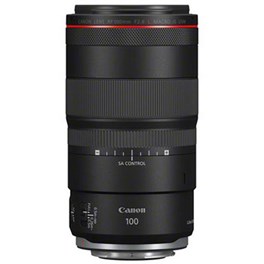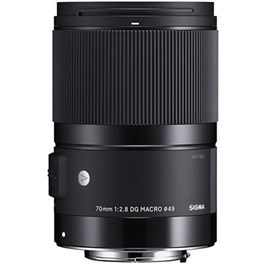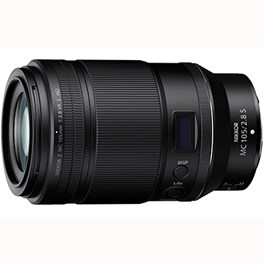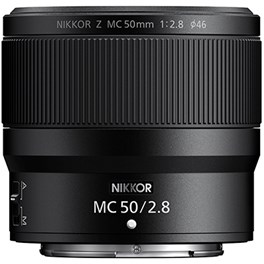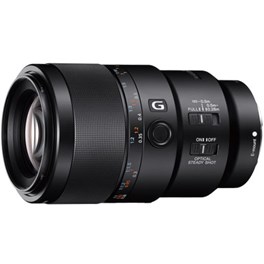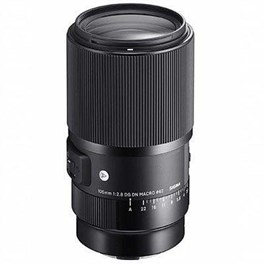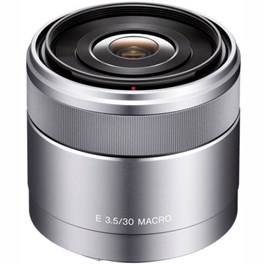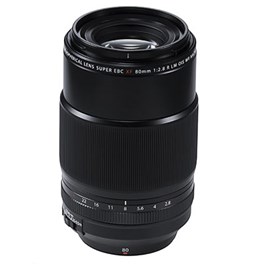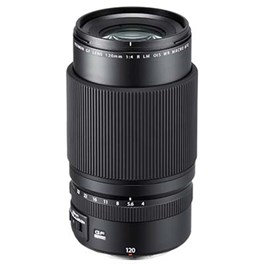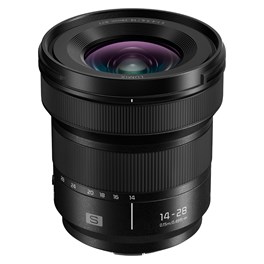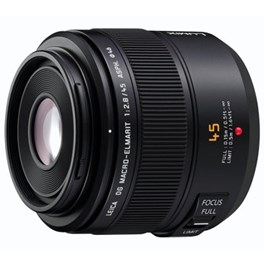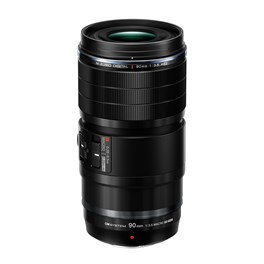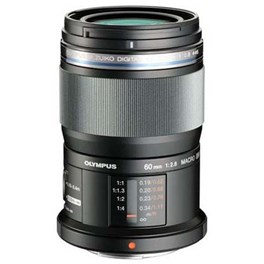
Having the best lens for macro photography is hugely important – arguably more so than the camera. A good macro lens needs to fulfil a number of key criteria, and when putting together this guide and making our picks, we’ve made sure to keep these in mind. As far as our technical team is concerned, the key characteristics of a macro lens are as follows:
1:1 magnification ratio (or better) - The magnification ratio refers to the relationship between the size of a subject and in real life and the size at which it is projected onto the sensor. At 1:1, or 1x, the subject is effectively rendered at life-size on the sensor plane. A macro lens is one that can focus in close enough to allow this, meaning that the tiniest subjects can be rendered in stunning detail. It’s not entirely essential (a 0.5x or 1:2 magnification ratio can still work) but it is very useful.
Telephoto focal length - Macro is often about filling the frame with a single subject, and as such, a tight telephoto focal length is hugely useful Macro lenses often tend to cluster around the 90-105mm mark – though as we’ll see, there is some variance in both directions.
Built-in stabilisation - It used to be a truism that macro shooters would always work on tripods. However, with optical stabilisation systems getting better and better, it has become much more possible to get sharp macro images while working handheld. As such, if a macro lens has effective optical stabilisation, it can make the user much more flexible in the types of subjects and images they can capture.
There’s more to discuss of course – you can scroll to the bottom of this page for our FAQs if you need more of a primer on how to choose macro lenses. Or, you can take a look at our detailed blog piece on what macro photography is! But if choosing a lens is your main focus, let’s get on with the show, and count off the best macro lenses for all the major camera systems…
Quick Navigation
Best Canon Lens for Macro Photography
If you’re shooting macro on Canon cameras, you’re likely to be choosing an RF mirrorless lens or an EF DSLR lens – and in both cases, there are some outstanding options out there. Canon is innovating brilliantly in the RF space, coming out with some dazzling lenses with some genuine world’s first features. The EF-mount meanwhile has an absolutely huge selection of lenses available – not just by Canon, but also from third-party manufacturers.
Remember that EF-mount lenses can also be used on EOS R DSLRs via the EF-EOS R adapter, so mirrorless users especially have a lot of choice available. Ultimately, though, whichever system you’re using, you’ll be able to produce terrific macro images with Canon kit. Here are our top picks…
Canon RF 100mm f2.8 L Macro IS USM Lens
A welcome addition to Canon's esteemed RF lens line up, the Canon RF 100mm F2.8L Macro IS USM Lens is a feat of optical performance and engineering. The lens's complex and intricate optical structure comprised of 17 lens elements arranged into 13 groups. This includes a floating focusing lens system that is driven by a Dual Nano USM autofocusing system that delivers lightning-fast, smooth and accurate AF performance with a near-silent operation. A defining feature of this lens is the addition of a specially designed Spherical Aberration Control ring that offers enhanced and expressive control of depth of field and bokeh, allowing you to alter the look of your bokeh and defocus both in front and behind your subject. As well as this, the lens provides up to 5-stop of image stabilisation compensation, and this can be increased when pairing this lens with a compatible RF-Mount Canon camera that features IBIS. Again, this lens is a feat of engineering and photographic understanding.
£1,369.00 View
Pros:
- 1.4x magnification
- Effective optical stabilisation
- Fabulous SA (bokeh) control
Cons:
- Not many!
A much-desired update to a classic of the genre, the Canon RF 100mm f2.8 L Macro IS USM is the successor to the legendary Canon EF 100mm f2.8 L Macro. However, this isn’t just a hasty reskinning of an old lens with a new mount – Canon has come out with something altogether different. This makes sense when you consider that EOS R users can simply adapt the old EF version to their newer cameras.
The RF 100mm offers outstanding close-up capabilities, with a maximum magnification of 1.4x allowing for the capture of tremendous levels of detail. The optical stabilisation is hugely effective; when paired with a compatible EOS R body, it can achieve up to eight stops of compensation. The other exciting addition is the SA (Spherical Aberration) control dial, which allows you to alter the shape and quality of bokeh to create a soft focus effect. It adds another creative string to the photographer’s bow, and makes this lens an essential purchase for the serious macro shooter working on RF-mount.
Sigma 70mm f2.8 DG Macro Art lens for Canon EF
The Sigma 70mm f2.8 DG Macro Art Lens is the first macro lens in the art line offering its users top-level performance at every shooting distance thanks to the incorporation of an extending, floating, two-group focus mechanism. The optical system utilises two FLD glass elements, two SLD glass elements, and one element featuring a high rate of anomalous partial dispersion in addition to high index of refraction. Combined these elements minimise axial chromatic aberration. The resolution has been increased at close shooting distances thanks to the two aspherical lens elements. In addition to this the user can achieve razor-sharp in-focus area which contrasts with a bokeh area free of colour streaking.
£449.00 View
Pros:
- Exceptional sharpness in a true macro lens
- Reasonably slim and light
- Great price
Cons:
- No stabilisation
- Lens physically extends when focusing
While you may just want to pick up the DSLR version of the RF 100mm f2.8 features above, for something different, we’d definitely recommend considering the Sigma 70mm f2.8 DG Macro Art lens. It’s considerably smaller and lighter than many macro telephotos, and still delivers the kind of premium sharpness and quality that close-up shooters demand.
Although it’s not stabilised, the Art lens is beautifully effective in most other respects. Its autofocus system is not entirely internal, meaning the front element does move a little when focusing, but the manual focus experience is wonderfully smooth and tactile. The large angle of rotation lets you get precise to a granular level with focusing, which combines well with the thin depth of field offered by the f2.8 maximum aperture.
Best Nikon Lens for Macro Photography
Nikon, it won’t surprise you to learn, offers some absolutely outstanding macro lenses. Whether you’re shooting on a mirrorless Nikon Z camera or a classic F-mount Nikon DSLR, you’ve got the enviable job of picking from some absolutely sublime macro optics. Remember that users of Nikon Z cameras can also use F-mount lenses via the FTZ mount adapter.
Also, the Nikon DSLR system being as well-established as it is, there are some terrific picks from third-party manufacturers – we’ve included an option on our list to remind you that it’s always worth looking beyond just the name that’s on your camera when it comes to buying lenses. Often there are real savings to be had, as well as the chance to pick up unique and interesting lenses to give your images a different look. Here are our picks of the Nikon lenses to use for macro shooting, including premium and budget options for both mounts.
Nikon Z MC 105mm f2.8 VR S Lens
As a leader in life-size shooting, the Nikon Z MC 105mm f2.8 VR S lens integrates a 1:1 reproduction ratio, fast-action focusing system, and a plethora of features suited to pro-level digital creatives. As a truly versatile macro lens, the Z MC 105mm f2.8 VR S has the capacity to shoot stunning stills and incredible video content with a clear emphasis on detail, sharpness, and colour contrast. The medium-telephoto angle of view further enables the production of dynamic portraits, with the fixed f2.8 rounded 9-blade aperture affording a rounded, natural, and stylised bokeh. You are guaranteed precise in-camera control and full flexibility to meet the demands of your individual creative workflow. This lens also has a key 0.29m minimum focus distance, with the AF focus limiter allowing for lightning-fast subject acquisition within a distance of just 0.29 - 0.50m.
£1,049.00 View
Pros:
- Lightweight and well-balanced
- Beautifully soft bokeh backgrounds
- Close focusing with 1:1 magnification
Cons:
- All plastic build
This sublime piece is one of Nikon’s ‘S’ lenses – this is the firm’s designation for its top-quality mirrorless lenses, fulfilling a similar function that ‘G Master’ does for Sony or ‘L’ does for Canon. The Nikon Z MC 105mm f2.8 VR S is a superb telephoto that ticks basically all the boxes a macro photographer is likely to care about. The focusing is smooth and fast, the magnification is life-size at 1:1, the stabilisation provides up to four stops of effective compensation – oh, yes, and the image quality is absolutely superb, with crisp details and punchy colours. We’d expect nothing less.
This lens isn’t too heavy for a full-frame telephoto, tipping the scales at 630g. Some who were fans of the old Nikon DSLR equivalent might bemoan the decision to move from a metal body to a plastic one. It doesn’t feel quite as robust, but it does help the lens stay light on its feet (so to speak), which is handy for prolonged handheld shooting.
Sigma 105mm f2.8 Macro EX DG OS HSM for Nikon F
The Sigma 105mm f2.8 Macro EX DG OS HSM is a high performance, large aperture medium telephoto macro lens that comes with an Optical Stabiliser (OS). The lens helps users to maintain an appropriate distance from the subject of their photos while still being able to take close-up images. It features SLD glass elements that provide fantastic control of aberration as well as a floating inner focus system that allows for high rendering throughout the focusing range. It is a true macro lens with a 1:1 magnification that produces stunning images.
£399.00 View
Pros:
- Absolute bargain at this price
- Dependably excellent image quality
- Nine-bladed diaphragm ensures nice-looking bokeh
Cons:
- No weather sealing
Like we said in the intro, going third-party when it comes to lenses is a great way to save yourself some cash, especially when working with older systems like Nikon F-mount. The Sigma 105mm f2.8 Macro EX DG OS HSM for Nikon F is quite an old lens – to the point where it predates Sigma’s ‘Art’, ‘Contemporary’ and ‘Sport’ designations – but it’s an absolute cracker of a lens that dependably delivers fantastic results. It’s a proper macro lens with a 1:1 reproduction ratio, and its optical path effectively minimises chromatic aberration for superb sharpness.
While it’s not weather sealed, this lens is stabilised, so can be used handheld more effectively to capture sharp shots. The elements have been treated with Sigma’s Super Multi-Layer Coating to reduce ghosting and flare for improved contrast and clarity. It’s just a great lens – one that has truly stood the test of time – and is worth every penny of its more-than-reasonable asking price.
Nikon Z MC 50mm f2.8 Lens
Made to the very same standards as the Nikon Z series of lenses and cameras, the Nikon Z MC 50mm f2.8 Lens is a high-quality, compact and lightweight macro prime lens. This lens offers the Nikon-standard image quality, sharpness and contrast, and can be used on both Nikon Z full-frame and Z DX camera bodies (offering a 35mm equivalent of 75mm.) Boasting macro magnification ratios of 1:4, 1:2, or 1:1 (life-size) and a focus limiter switch, this lens is able to produce stunning macro imagery that is guaranteed to impress. As much of a macro lens as this is, it has a classic 50mm focal length which enables this lens to be used for a wide range of photographic disciplines e.g. street or portraiture. This is aiding by the maximum f2.8 aperture that offers enhanced low-light performance, control of depth of field and can capture beautiful bokeh.
£679.00 View
Pros:
- Works great with FX and DX
- Small and lightweight
- Affordable price tag
Cons:
- No Vibration Reduction
This is the more affordable of the macro lenses for the Z system, and it’s a terrific starting point. While it is a full-frame lens, it’ll also work well with Nikon’s DX-format Z-mount cameras like the Z50 and the Z fc. In fact, with a 75mm equivalent focal length on APS-C, it might well be slightly better suited to those cameras for a lot of macro shooters. If you’re currently using a DX-format Nikon Z mirrorless camera, this is a great lens to buy, particularly because you’ll be able to keep using it if you upgrade to full frame in the future.
Delivering excellent image quality, particularly in the centre, the Nikon Z MC 50mm f2.8 is a fantastic choice for macro work, at an affordable asking price. Some sacrifices have been made to keep it slim and inexpensive – probably the most significant is the lack of Vibration Reduction, which may restrict you to tripod use only.
Best Sony Lens for Macro Photography
Whether you’re using a full-frame or an APS-C Sony mirrorless camera, you’ve got plenty of macro lenses to choose from. The E-mount has been running for a long time, and plenty of great lenses have been developed for the system of the years. With resolutions of Sony cameras climbing ever higher, it pays to get a lens that offers the kind of sharpness to make the most of all those pixels. Sony has proven up to the challenge of offering suitable options.
We’ve picked out both a full-frame (FE) lens and an APS-C (E) lens for Sony users looking to shoot macro. Remember that APS-C shooters can also use full-frame optics; you just have to remember the 1.5x crop factor will increase the effective focal length, and that the overall setup might end up being a little front-heavy.
Sony FE 90mm f2.8 Macro G OSS Lens
The Sony FE 90mm f2.8 Macro G OSS lens is the first full frame E-mount medium telephoto macro with built-in image stabilisation to deliver crisp, high-resolution images with beautiful bokeh. A floating focus mechanism ensures that consistently superior optical performance is achieved at all focusing distances. The lens features a 1:1 magnification ratio and 0.28m minimum focusing distance.
£849.00 View
Pros:
- Excellent sharpness with well-controlled aberration/distortion
- Effective built-in stabilisation
- Dust/moisture resistance
Cons:
- A little softness when used wide open
This macro lens from Sony was the first full-frame E-mount lens to feature built-in image stabilisation, making hand-held macro images much more achievable than they were previously. And what a lens this is – it bears Sony’s ‘G’ designation, which means it’s been optimised to produce exceptional bokeh in the defocused areas of images. Edges are rendered beautifully smoothly, and the nine-bladed aperture ensures an aesthetically pleasing falloff.
Sharpness is top-tier, with aberration and distortion controlled very well to produce crisp and punchy macro images. The autofocus, powered by Direct Drive SSM, is quick and effective, and this combined with the aforementioned stabilisation means you stand an improved chance of capturing sharp images of flighty subjects like insects. With a body design that’s resistant to dust and moisture, this is a lens that’s great for exploring the outdoors with.
Really, there’s very little we can say to criticise this lens – it’s sharper at f4 than f2.8, but that’s entirely expected, and the wide open results it gets are more than acceptable. For full-frame macro photography on Sony, this lens should be your first port of call.
Sigma 105mm f2.8 Macro DG DN Art Lens for Sony E
A welcome addition to Sigma's Art lens line-up, the AF 105mm f2.8 Macro DG DN Art Lens is designed for smooth, efficient and creative shooting. It has an advanced optic layout built up of 17 glass elements in 12 groups, including 1 SLD element. In addition, it has a 9-blade rounded aperture diaphragm which offers enhanced control of depth of field as well as providing beautiful smooth out-of-focus areas in your images or video. This lens is suited for both close-up macro work as well as for a wide range of other uses, such as stunning portraiture. The AF system features a Hyper Sonic Motor (HSM) which offers super-quiet, fast and accurate autofocus which is complement by an on-barrel focus limiter switch which will offer even faster AF performance when the time calls for it. As with all Sigma lenses, a high-quality and versatile build is guaranteed. The lens features various advanced functions including an aperture ring with de-click and lock functions, a customisable AFL button and versatile dust- and splash
£664.00 inc. Cashback View
Pros:
- Superb performance for the price
- Useful features like focus limiter
- Rapid autofocus
Cons:
- No stabilisation
A deservedly famous lens among macro aficionados, this third-party telephoto prime is available for L-mount as well as Sony E-mount. Delivering outstanding performance at an impressively reasonable asking price, the Sigma 105mm f2.8 Macro DG DN Art Lens merits serious consideration by any Sony photographer looking to shoot close-ups. Its focusing system, powered by a Hyper Sonic Motor, is fast and effective, and you can make use of the handy Focus Limiter switch to restrict it to a specific area.
There’s no stabilisation – though in fairness, most full-frame Sony cameras have their own. If you’re using one that doesn’t, like an early Alpha 7 camera for example, the FE 90mm featured above is possibly a better choice, but otherwise this Sigma lens has a lot of reasons to be the first port of call on your list.
Sony E 30mm f3.5 Macro Lens
The Sony E30mm f3.5 Macro Lens for E mount cameras offers full 1:1 magnification for detailed close-ups of flowers, insects and small subjects. Its superb image quality makes the E30mm f3.5 Macro Lens equally suited to HD video and an ideal companion to Sony's latest range of APS-C E-mount cameras.
£185.00 View
Pros:
- Very affordable for a 1:1 macro lens
- Focuses quickly
- Lightweight and portable
Cons:
- No stabilisation or weatherproofing
- Short focal length for a macro
This is one of Sony’s most affordable APS-C lenses, and yet it’s still a ‘true’ macro lens with the proper 1:1 magnification ratio. Seems like witchcraft, but somehow Sony has done it, and if you’re using a crop-sensor camera like the A6000 or the newer A6700, it’s a wonderfully inexpensive and portable lens to pick up. Sharpness is very good in the centre of images, and the autofocus is reliably quick and efficient.
The equivalent focal length the lens produces is 45mm – this is definitely quite short for a macro, and will require you to get pretty close to your subjects. Fortunately, the close-focusing skills of the Sony E 30mm f3.5 Macro are up to the challenge – the main difficulty will be trying not to block out your own light! Shooting on a tripod will be helpful here, especially since the lens doesn’t have any built-in stabilisation.
Best Fujifilm Lens for Wedding Photography
Fujifilm offers two outstanding mirrorless systems for macro photographers – the APS-C X-mount cameras and the medium format GFX series. Either way, you’re getting a camera that produces terrific images with punchy colours and excellent contrast. So it pays to get a macro lens that’ll do it justice.
We’ve picked out a macro lens for each system, both of which are produced by Fujifilm. The firm is known for producing cracking lenses that offer both superlative sharpness and beautiful, creamy bokeh, and these optics are of course no exception. Fujfilm systems aren’t as extensively populated as some others, but here there’s a firm emphasis on quality over quantity, and you can be confident that you’ll be getting an outstanding lens with fast focusing, a durable build and (in both these cases) highly effective stabilisation. Let’s take a closer look.
Fujifilm XF 80mm f2.8 LM OIS WR Macro Lens
Whether you are entering the world of macro photography or adept in the subtle style, the Fujifilm 80mm f2.8 XF LM OIS WR Macro Lens is a perfect option. The maximum F2.8 aperture, focal length that's equivalent to 122mm (in 35mm format) and 1.0x magnification factor means this lens is capable of capturing some stunning close up shots. Unlike some macro lenses, this lens supports hand-held use with the built-in optical image stabiliser which means you can take this lens out into the field without the need for additional kit. Finally, this is a Fujifilm lens after all and with that, a high quality build and beautifully ergonomic design is ensured. Take a look at the gorgeous sample images below!
£1,049.00 View
Pros:
- Outstanding sharpness with excellent CA control
- Excellent image stabilisation
- Beautiful bokeh quality
Cons:
- A considerable investment
- On the hefty side at 750g
The luminous beauty is still the macro lens for Fujifilm X photographers. It came out a few years before Fujifilm started putting 40MP sensors into its cameras, but fortunately the XF 80mm f2.8 LM OIS WR Macro has the level of sharpness necessary to cope with that kind of detail. It produces images of delectable detail, controlling for aberration, distortion and vignetting to the point where they’re essentially a non-issue.
Fujifilm’s highly effective optical stabilisation is on board here for hand-held shooting, and the bokeh produced at shallow depths of field is simply gorgeous thanks to the nine-bladed aperture (as is often the case with Fuji lenses). It’s a relatively heavy beast at 750g, and the price puts it at the premium end of the scale – but it’s unquestionably a worthwhile investment for the committed macro shooter.
Fujifilm GF 120mm f4 R LM OIS WR Macro Lens
Designed for use with the Fujifilm GFX 50S, the Fujifilm GF 120mm f4 R LM OIS WR Macro Lens is a medium telephoto lens with a maximum magnification of 0.5x. It features a construction of 9 groups and 14 elements, including 3 ED elements, and delivers high-quality images free of aberrations. Its linear focus motor ensures autofocusing is fast and silent. This macro lens produces a beautiful bokeh effect.
£2,499.00 View
Pros:
- Superb optical quality
- Extensively weather sealed
- Five-stop stabiliser
Cons:
- Not ‘true’ macro (0.5x magnification)
Shooting macro on one of Fujifilm’s sublime mirrorless medium format cameras? The GF 120mm f4 R LM OIS WR Macro has arrived to answer your prayers, delivering gorgeous close-up quality in a useful 95mm equivalent focal length (remember that the crop factor works the other way when dealing with sensors larger than full-frame). With full weather seals across the body, this is an outdoorsy lens that will cope well with frosty mornings, wet weather and more. There’s also an effective five-stop stabilisation system.
Sharpness is great – obviously. It always is on the GF mount. This isn’t technically a ‘true’ macro lens, with a magnification factor of 0.5x rather than 1.0x, but it will definitely still produce excellent macro images, with punchy colours and excellent contrast. The minimum working distance is a respectable 45cm, and you’ve got plenty of latitude to throw out the background with the f4 maximum aperture (the closer you get, the better).
Best Panasonic Lens for Macro Photography
As Panasonic produces two distinct lines of cameras, we’ve included a macro suggestion for both on our list. The Lumix S full-frame cameras use the L-mount, meaning they can make use of a broad suite of lenses from not only Panasonic but also Sigma and Leica. We’ve picked out a Panasonic lens here, but it’s definitely worth looking at all the options.
The older Panasonic line is, of course, the good old Micro Four Thirds range. Once again this is a collaborative system, supported also by Olympus / OM System, so you can check out the section below this one for lenses that will also fit your Panasonic Lumix G camera. As ever, we’ll remind you to double-check you’re getting the right fit before you buy – there’s no cross-compatibility at all between L-mount and MFT. It’s Lumix S for the former, Lumix G for the latter, and never the twain shall meet.
Panasonic LUMIX S 14-28mm f4-5.6 Macro Lens
Panasonic’s Lumix 14-28mm f4-5.6 Macro Lens is a new ultra wide-angle zoom lens with macro capabilities. Designed for L-Mount systems cameras, the versatile zoom range is useful for any project, from epic landscape photography to expressive portraiture and detailed macro shots. The lens construction offers stunning clarity and gorgeous bokeh, and the rugged, compact build adapts to any situation.
£699.00 View
Pros:
- Wide zoom range provides potential for unique macro images
- Great value for money
- 15cm minimum focusing distance throughout zoom range
Cons:
- May be challenging to use at first
- Not a ‘true’ macro lens, with 0.5x magnification at narrow end
Hang on a tick, you might be saying. We’ve been pretty much exclusively recommending telephoto primes up to this point, and suddenly a wide-angle zoom has muscled its way onto the list. What gives? Yes, the Panasonic LUMIX S 14-28mm f4-5.6 Macro is something of an unusual beast, and if you want something more conventional for L-mount, you can check out the L-mount version of the Sigma 105mm f2.8 Macro DG DN Art Lens featured in the Sony section of the round-up. However, for creating close-up images with an altogether different look, the LUMIX S 14-28mm f4-5.6 Macro lens is well worth considering.
It’s got a close focusing distance of 15cm that’s constant throughout the zoom range, and when you zoom in fully to 28mm you get a pretty respectable reproduction ratio of 0.5x. The image quality is gorgeous, with excellent management of distortion and aberration, and even with a comparatively narrow maximum aperture of f5.6 down the tele end, it’s still more than possible to produce images with delightfully smooth bokeh.
Panasonic 45mm f2.8 Macro Leica D Vario- Elmar Micro Four Thirds lens
The Panasonic Micro 4/3rds 45mm f2.8 Leica D Vario-Elmar Lens boasts a superb image quality with minimum distortion or chromatic aberration. Ghosting and flare are also reduced thanks to an aspherical lens and an ED lens that both form part of the 14 element construction. Despite its impressive performance the 45mm f2.8 Leica D Vario-Elmar Lens is both light and compact, taking advantage of the Micro Four Thirds standard to achieve dramatic downsizing. Panasonic's MEGA O.I.S. (Optical Image Stabilizer) suppresses the blurring caused by hand-shake, making it easier to shoot sharply focused macro shots, even in dimly lit places, without using a tripod. The closest focusing distance can be instantly changed to 15 cm or 50 cm (0.5 ft to 1.64 ft) with the switch on the lens barrel according to the shooting opportunity. As well as macro photography, the Panasonic Micro 4/3rds 45mm makes an excellent portrait lens.
£599.00 View
Pros:
- Lovely manual focus ring
- Great quality with well-controlled CA
- Optical stabiliser
Cons:
- Not weather sealed
With an equivalent focal length of 90mm, the Panasonic 45mm f2.8 Macro Leica D Vario-Elmar is a short telephoto that’s well pitched for macro shooting. Its maximum aperture is f2.8 and it performs very well at that setting, so don’t be afraid to open it up for bokehlicious results. We love in particular how lightweight this lens is – it pairs brilliantly with Lumix G cameras – and the inclusion of Panasonic’s Mega OIS for increased latitude when it comes to shooting handheld.
While the autofocus on this lens is excellent, we particularly enjoy the manual focusing experience thanks to the nice and wide focusing ring on the barrel. Image quality is great, with effective suppression of distortion and aberration, making for a capable and versatile close-up lens.
Best Olympus/OM System Lens for Macro Photography
Olympus and OM System cameras are excellent choices for macro work. With excellent image quality, responsive operating systems, and extensive weatherproofing in the case of the more recent OM System models, these Micro Four Thirds mirrorless cameras are ideal for a day spent exploring outside for natural macro opportunities.
Remember that the shared compatibility of the Micro Four Thirds system means you can also use Panasonic Lumix G lenses on your Olympus or OM System camera. And once again, the 2x crop factor of MFT means that the effective focal length of a lens will be double the stated focal length (hence why at first glance these lenses might seem oddly short compared to the others). This does have the advantage of meaning the lenses can be made much more compact than equivalent telephotos for other systems, meaning the overall camera/lens combination is much more lightweight and portable.
OM SYSTEM M.Zuiko Digital ED 90mm f3.5 Macro IS PRO lens
The new M.Zuiko Digital ED 90mm f3.5 Macro IS PRO is a highly versatile macro lens for field or studio photography. It has a 180mm equivalent focal length on 35mm format cameras and features an impressive 18 elements in 13 groups. This Micro Four Thirds lens is also dust-, splash-, and freeze-proof, with intuitive controls and advanced image stabilisation, so you can shoot in all conditions.
£1,299.00 View
Pros:
- Extensive weatherproofing
- Very effective stabiliser with 7 EV steps compensation
- 2:1 magnification ratio
Cons:
- Tight field of view requires compositional precision.
As this is a more recent OM System lens, it comes with the same level of weather-sealing as the OM cameras, so you should have no fear taking it out for a day’s shoot in the wild and the wet. The OM SYSTEM M.Zuiko Digital ED 90mm f3.5 Macro IS PRO delivers an equivalent focal length of 180mm, which is quite long even for a macro, and will mean tight compositions are a must.
The good news is the impressive 2:1 magnification ratio, doubling the size of your subject on the sensor for super-detailed close-ups. You could even extend that magnification with teleconverters if so desired – the lens supports them. OM System’s effective seven-stop stabilisation is also on board, helping to control camera-shake while working at such a long focal length. Physically, this lens is quite large and long, especially for relatively small MFT cameras, but the quality and ease of use it delivers are beyond reproach.
Olympus M.Zuiko Digital ED 60mm f2.8 Macro Lens
The Olympus 60mm f/2.8 M.ZUIKO Digital ED Micro Four Thirds Lens is a dedicated macro lens with a robust, lightweight design and a fast aperture of f/2.8. It features a dust and splash proof body making it an ideal lens for outdoor use. Being a dedicated macro lens, it lets you take shots at close range in true (1:1) life size, as well as offering continuous focusing from 0.19m to infinity.
£449.00 View
Pros:
- Excellent value for money
- Completely internal focusing system
- Useful f2.8 maximum aperture
Cons:
- Not stabilised
For a budget-friendly macro lens that still delivers the goods, we really rate the Olympus M.Zuiko Digital ED 60mm f2.8 Macro. With an equivalent focal length of 120mm, it’s right in the popular sweet spot for macro shooting, and it delivers 1:1 magnification for perfect close-ups. Close-focusing distance is impressively short at 19cm, and the focusing system is nice and sprightly. It also works entirely internally, meaning the size and balance of the lens don’t change when focusing – which can cause issues when working at super-close distances.
This is also a comfortable lens to use to focus manually – which as we know, many macro photographers prefer. It’s got a nice, big focusing ring with a smooth turn. The bokeh it produces in defocused areas of images is also nicely circular, making for aesthetically attractive backgrounds.

FAQs
What is a macro lens used for?
Macro lenses are designed for close-up photography. They allow you to capture the smallest details that you wouldn’t otherwise see with other lenses or even the naked eye. These lenses are often used to photograph insects, flowers and fine textures. However, some utilise the wide aperture and tight field of view for portraiture too.
How do macro lenses differ from regular lenses?
The closer minimum focusing distance of macro lenses allows you to capture subjects at a 1:1 ratio or higher. What does this mean? It means that the subject you capturing can be reproduced at life-size on the camera sensor, providing incredible detail not typically achievable with standard lenses.
Can I use a macro lens for non-macro photography?
By all means. Macro lenses are often used for portrait photography thanks to their tight field of field and increased control of depth of field.
What is the meaning of 1:1 magnification ratio in macro lenses?
A 1:1 magnification ratio means that the subject being photographed can be reproduced on the camera sensor at its actual size. Higher magnification ratios, such as 2:1 or 5:1, indicate the ability to capture subjects at larger-than-life sizes.
How does image stabilisation benefit macro photography?
Image stabilisation (IS) is important for macro photography as the impact of camera shake (caused by hand movements or other factors) is more pronounced at closer focusing distances. As a result, images come out sharper which is important when trying to highlight fine details.
Do I need additional lighting for macro photography?
Natural lighting is ideal but can be reproduced with artificial lighting. Furthermore, the use of ring flashes or flash guns can help evenly light your subjects, reduce shadows and help make the subject pop.
Can you use extension tubes instead of a macro lens?
While you can use extension tubes on a regular lens to turn it into a macro lens (distance between the lens and the camera sensor), the overall performance and final images will not be as clean or sharp as a dedicated macro lens.
How do we decide?
Our in-house photography experts, store staff and partners all work collaboratively to pour over these guides. The cameras and equipment recommended in our guides are based on their personal opinion, empirical experience and of course, feedback from our customers.
We way up price, features, quality and the all-important 'je ne sais quoi' to make sure we recommend products that will delight and inspire.
If you would like more advice on any purchase our contact centre staff are here to help. Alternatively, you can reach us via email or social media.
And don't forget. If you were to purchase anything based on our recommendations you'll be covered by our full returns policy
Buying Guides

